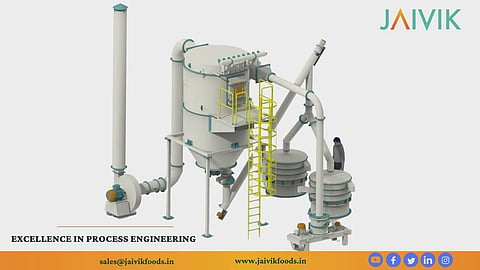Importance of temperature control during the Grinding Process
Spices are an inevitable part of every Indian household. It is a commodity that has spread its wings far and wide as consumers around the globe get hooked on the invigorating impact that spices have on their taste buds. Spices offer a myriad of uses such as being used as preservatives, imparting flavor, aroma, and even healing within the food and pharmaceutical industry.
The quality of any spice can be determined by its intrinsic and extrinsic traits which are closely dependent on the processing techniques applied to them. Grinding is one such process that spices are impacted by. Selection of the grinding mechanism is the first and most crucial step, as it greatly impacts particle size distribution. Some techniques applied during the grinding of spices include conventional grinding (hammer, pin mill) and advanced grinding (cryogenic, dry ice, chilled air, level grindings, among others). Impact, compression, shear, and cutting are some of the mechanical means by which particle size in spices is reduced.
The mill type influences the rate and amount of heat generated during grinding, the principle of grinding, the degree of grinding, and the material's properties. At Jaivik, the customized design of mills can achieve precise outputs of any input, with at least four feed options, two hammer types, and different screens. They are also operation friendly.
Heat-induced quality loss is a primary technical challenge in spice grinding. Significant losses in product quality occur due to heat generation and hence need to be focused on. To protect heat-sensitive and volatile components, grinding should be performed under reduced temperature. Besides quality loss, temperature also results in clogging, higher oxidation of the product, higher energy consumption, and also induces tensile residual stress, reducing the tool life. To achieve a high-quality end product with all its nutritional and physical qualities intact, minimizing heat generation and quick removal of heat during grinding is essential.
The Jaivik solution
Jaivik size reduction equipment such as JVHM (Jaivik Hammer Mill), JVCM (Jaivik Classifying Mill), JVUM (Jaivik Universal Mill), and JVSRC (Jaivik Cutter Mill) are designed to grind the spices without impacting their quality.
Keeping customer satisfaction as a priority, Jaivik Foods has specially designed a process within its mills for low-temperature grinding. This process reuses the heat generated during the grinding process. This in turn saves the customers huge financial costs on account of energy usage, wear and tear of equipment, and manual work. The customized process promotes dust-free operations and is abrasion resistant. It offers accuracy and efficiency that ensure the customers receive premium quality spice quality, color, and other organoleptic properties. The mills are programmed and can be adjusted to grind solids into coarse and fine powder forms.
Explore Jaivik Foods latest offering and offer spices that stay nutritious till the time customers consume them!
Click HERE to subscribe to our FREE Weekly Newsletter


